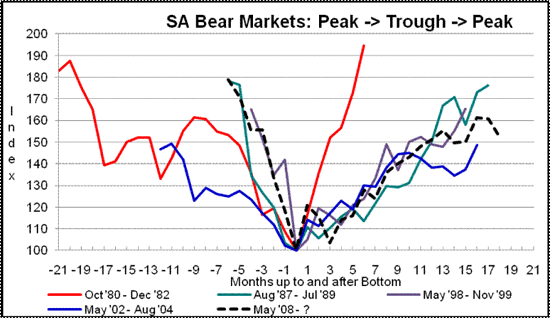In today’s newsletter we take a look at the recovery and share some economic and equity investment thoughts; and we look at savings for the youth. In this exceptionally cold and yet happy time for the country we need to remember that in three weeks we will again return to the real world where financial matters need to be faced and conquered.
We wish Bafana Bafana the best of luck in their final group stage match next Tuesday and will be blowing the Vuvuzela in support of the national side.
The length of the recovery
In the latest Cadiz Asset Management Market View, portfolio manager Matt Brenzel provides some insightful comments. He shows the below graph that plots the performance of the JSE All Share Index during the last 5 bear markets, tracing the time it took for the index to move from its peak level before the crack, to the trough and back to that previous peak.

“Other than during the correction of 1980,” Brenzel notes, “it is evident that it took the market longer to recover from the body blows than it had taken to fall. In the current cycle, the collapse occurred over a brief 6 months and the recovery phase is now into its 18th month – and still some 15% short. In terms of the duration of recovery, the current phase has taken longer than those of the 1987 and 2002 bear markets and looks to be approximating those of 1969 and 1974 (not shown), which took about 30 months to recover. If this were to repeat, the JSE would only be back at May 2008 levels by May next year.”
Debt has to go down
Brenzel comments that events since the term ‘sub-prime’ first became the hot topic of conversation point to one conclusion: the world’s debt mountain has to be whittled down before financial markets can get back to any semblance of normality.
“The penny has dropped that moving debt from the private sector to the public sector presents only a temporary respite. Any which way you cut it, the world will have to change its mindset from one of spending to one of financial prudence. As the pictures on consumer reaction in Greece have shown, this prospect is not universally appreciated. Indebted governments will have to display greater conservatism and fiscal discipline. Conversely, countries such as China have a greater amount of flexibility.”
Inflation, interest rates and growth low
He says that inflationary pressure will remain muted from both a demand-pull as well as a cost-push perspective as the consumer battens down the hatches and corporates experience low pricing power. “This will ensure lower interest rates for longer.”
This means lower growth.
“Implicit in greater consumer and public sector forbearance is a lower growth trajectory for most economies as well as a rollback in targeted returns – both nominal and real – for most asset classes, more specifically those with a higher risk profile.”
Emerging markets again remain better off – but they won’t be totally immune to other economies’ growth paths.
“Whilst the emerging markets have to some degree been protected by virtue of their better financial health, demographics and corporate returns, they cannot entirely escape what is happening in the developed markets. With approximately 25% of South Africa’s exports heading into Europe, the weakening of the euro by 37% against the rand must hurt.”
Brenzel says that South African corporates in general have a reputation for being able to pass on cost increases given the lack of competition in our economy. “One has to wonder how sustainable this will be in future given the impact of expected administered and other price increases on the consumer. Labour militancy will no doubt continue to garner above inflation wage increases and without a concomitant increase in productivity, margins and profitability will erode.”
What does this mean for equity investors?
Brenzel says that the picture painted above might induce some equity investors to fall on their swords. What provides us with comfort though, he notes, are the following:
i) the consensus forecasts for both economic and corporate earnings growth are positive over the next few years;
ii) we assume that the required fiscal management will be imposed by those countries whose leaders are able to look beyond political expediency;
iii) monetary policy will remain accommodative for a while yet;
iv) the US will once again assume the mantle of the world’s leading economy as it is further through the adjustment cycle than others. A more stable economy implies a more stable equity market;
v) the Chinese miracle will continue, although at a more subdued pace, and;
v) that the value style will continue to provide superior returns.
South Africa’s youth and savings
Latest government statistics for the first quarter of 2010 show that nearly 50% of South Africans between the ages of 16-24 and 28% of those aged between 25-34 are unemployed.
According to Seelan Gobalsamy, MD of Old Mutual Corporate, these statistics, combined with research findings by Old Mutual show that less than a third of South Africa’s youth have any kind of retirement savings vehicle in place.
This could have a devastating knock-on effect for the ability of young South Africans to retire comfortably in the decades to come. Gobalsamy says that contributions made to a retirement fund early in one’s working life are the most important.
“While retirement may seem a long way away to someone in their twenties, it is vital that people begin saving as early as possible. Basically, thanks to the power of compound interest, the longer your money is invested, the more time it has to grow.”
He says that waiting even a few years before starting to save for retirement can have a massive impact on your final retirement savings.
Gobalsamy says another factor that impacts on younger workers is that they are often excluded from the benefits that many other workers take for granted. “Young people are more likely to have jobs without health and retirement benefits as they are often given entry level jobs and only accrue these forms of benefits in later years.”
However, he says that even when they are given the opportunity to access a retirement fund, many pass on the opportunity as they feel they would rather start at a later stage when they can more easily afford payments.
According to a recent Old Mutual survey, 53% of working South Africans have access to retirement savings vehicles such as pension or provident funds, yet just 28% of the under-30’s are members of these funds.
“People need to start viewing the idea of saving for retirement as a necessary expense such as insurance or fuel.”
Our tax system does not sufficiently incentivise late-starters to save more for retirement, and many retirement funds still don’t allow flexible contributions,” says Gobalsamy.
“Considering the savings position of many South Africans under 30, a review of this stance is probably long overdue.” Recent industry research indicates that people are retiring around age 61 with only 20 years worth of contributions to retirement funds, as they cash in their retirement savings when they change jobs.
At an average contribution rate of 11% of salary – at retirement – most pensioners receive below 30 % of their last monthly salary as a monthly income.
“A calculation by Old Mutual Actuaries and Consultants show that people who start contributing again to a retirement fund at age 32, will typically have 29% less savings at retirement age, compared with someone who started saving for retirement at age 21. If you start over at age 37, you could have up to 42% less retirement savings than someone who never cashed in their retirement savings when they changed jobs.”
In addition, results from the Old Mutual Retirement Monitor Survey 2010, confirm that 23% of pensioners currently receive financial assistance from others.
This assistance makes up almost a quarter of their income.
Although South Africa’s life expectancy has fallen to below 50 because of HIV/Aids, statistics show that once a person has reached the age of 60 the pandemic is no longer a major risk factor and longevity becomes the primary risk for having sufficient retirement funding.
When you retire, you also need to take into consideration how much money you would need to spend on medical costs.
People therefore need to be aware of the fact that just contributing to your company pension fund might not provide you with sufficient savings at retirement if you have taken some of your retirement savings in cash during any stage of your working life.
Old Mutual research also indicates that if a person retires at age 65, while contributing 11% of their monthly salary (employer contribution included) for a period of 40 years, they will receive a monthly income from their retirement savings equal to 79% of their last monthly salary, which should be sufficient to retire comfortably.
Gobalsamy added that “poor savings habits coupled with the high rate of unemployment will definitely have an enormously negative effect on South African pensioners in future. By the time today’s younger generation retires; their retirement savings will most likely be insufficient to meet their needs”.
The comment and opinion in this newsletter is comment and opinion only. Please consult a professional and registered financial adviser for all financial decisions and make sure they are taken in accordance with an appropriate financial plan that takes into account all short and long term financial and other goals.

